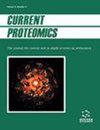Curcumin Reverts the Protein Differential Expression in the Liver of the Diabetic Obese db/db mice
IF 0.5
4区 生物学
Q4 BIOCHEMICAL RESEARCH METHODS
引用次数: 1
Abstract
In type 2 diabetic mouse liver, hyperglycemia, and insulin modify gene expression. Curcumin is a powerful antioxidant and antidiabetic agent that regulates the gene expression of different signaling pathways through various transcription factors. Therefore, we hypothesized that curcumin modifies the protein expression profile in the liver of diabetic db/db mice. To determine the effects of curcumin on the liver protein profile of diabetic db/db mice. db/db and wild type (WT) male mice were allocated in four groups, and they were fed for eight weeks. Three WT and three diabetic db/db mice received a standard diet (SD; WT and db/db groups, respectively); three WT and three diabetic db/db mice received a SD supplemented with 0.75 % (w/w) curcumin (WT+C and db/db+C groups, respectively). Liver proteins were separated by 2D electrophoresis. Differential protein expression analysis was performed on ImageMaster 2D Platinum software, and selected proteins were identified by MALDI-TOF-MS and subjected to enrichment analysis using STRING and DAVID databases. Thirty-six proteins with differential expression due to the diabetic background and curcumin treatment were found; these proteins participate in the metabolism of amino acids, carbohydrates, and lipids. Interestingly, the altered expression of seven proteins was prevented in the liver of the diabetic mice that received curcumin. Among all differentially expressed proteins, curcumin reverted the altered expression of seven proteins. Thus, although it was observed that curcumin did not affect the biochemical parameters, it does modify the expression of some liver proteins in diabetic mice.姜黄素恢复糖尿病肥胖db/db小鼠肝脏蛋白差异表达
在2型糖尿病小鼠肝脏中,高血糖和胰岛素改变基因表达。姜黄素是一种有效的抗氧化和抗糖尿病药物,通过多种转录因子调节不同信号通路的基因表达。因此,我们假设姜黄素改变了糖尿病db/db小鼠肝脏中的蛋白质表达谱。为研究姜黄素对糖尿病db/db小鼠肝脏蛋白谱的影响,将野生型雄性小鼠db/db分为4组,饲养8周。3只wt3和3只糖尿病db/db小鼠接受标准饮食(SD;WT组和db/db组);3只WT和3只db/db糖尿病小鼠分别饲喂添加0.75% (w/w)姜黄素的SD (WT+C组和db/db+C组)。用二维电泳法分离肝脏蛋白。在imagemaster 2D Platinum软件上进行差异蛋白表达分析,选择的蛋白通过MALDI-TOF-MS进行鉴定,并使用STRING和DAVID数据库进行富集分析。由于糖尿病背景和姜黄素治疗,我们发现了36种不同表达的蛋白,这些蛋白参与氨基酸、碳水化合物和脂类的代谢。有趣的是,在接受姜黄素治疗的糖尿病小鼠的肝脏中,7种蛋白质的表达改变被阻止了。在所有差异表达蛋白中,姜黄素恢复了7个蛋白的改变表达。因此,虽然观察到姜黄素不影响生化参数,但它确实改变了糖尿病小鼠某些肝脏蛋白的表达。
本文章由计算机程序翻译,如有差异,请以英文原文为准。
求助全文
约1分钟内获得全文
求助全文
来源期刊

Current Proteomics
BIOCHEMICAL RESEARCH METHODS-BIOCHEMISTRY & MOLECULAR BIOLOGY
CiteScore
1.60
自引率
0.00%
发文量
25
审稿时长
>0 weeks
期刊介绍:
Research in the emerging field of proteomics is growing at an extremely rapid rate. The principal aim of Current Proteomics is to publish well-timed in-depth/mini review articles in this fast-expanding area on topics relevant and significant to the development of proteomics. Current Proteomics is an essential journal for everyone involved in proteomics and related fields in both academia and industry.
Current Proteomics publishes in-depth/mini review articles in all aspects of the fast-expanding field of proteomics. All areas of proteomics are covered together with the methodology, software, databases, technological advances and applications of proteomics, including functional proteomics. Diverse technologies covered include but are not limited to:
Protein separation and characterization techniques
2-D gel electrophoresis and image analysis
Techniques for protein expression profiling including mass spectrometry-based methods and algorithms for correlative database searching
Determination of co-translational and post- translational modification of proteins
Protein/peptide microarrays
Biomolecular interaction analysis
Analysis of protein complexes
Yeast two-hybrid projects
Protein-protein interaction (protein interactome) pathways and cell signaling networks
Systems biology
Proteome informatics (bioinformatics)
Knowledge integration and management tools
High-throughput protein structural studies (using mass spectrometry, nuclear magnetic resonance and X-ray crystallography)
High-throughput computational methods for protein 3-D structure as well as function determination
Robotics, nanotechnology, and microfluidics.
 求助内容:
求助内容: 应助结果提醒方式:
应助结果提醒方式:


